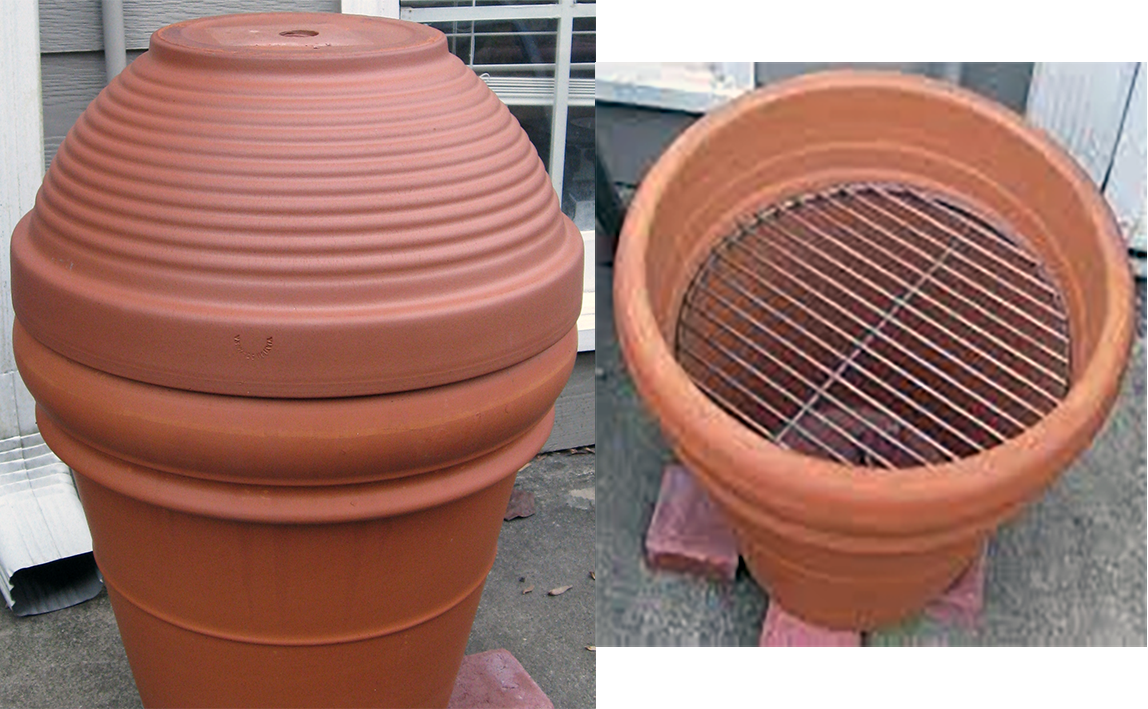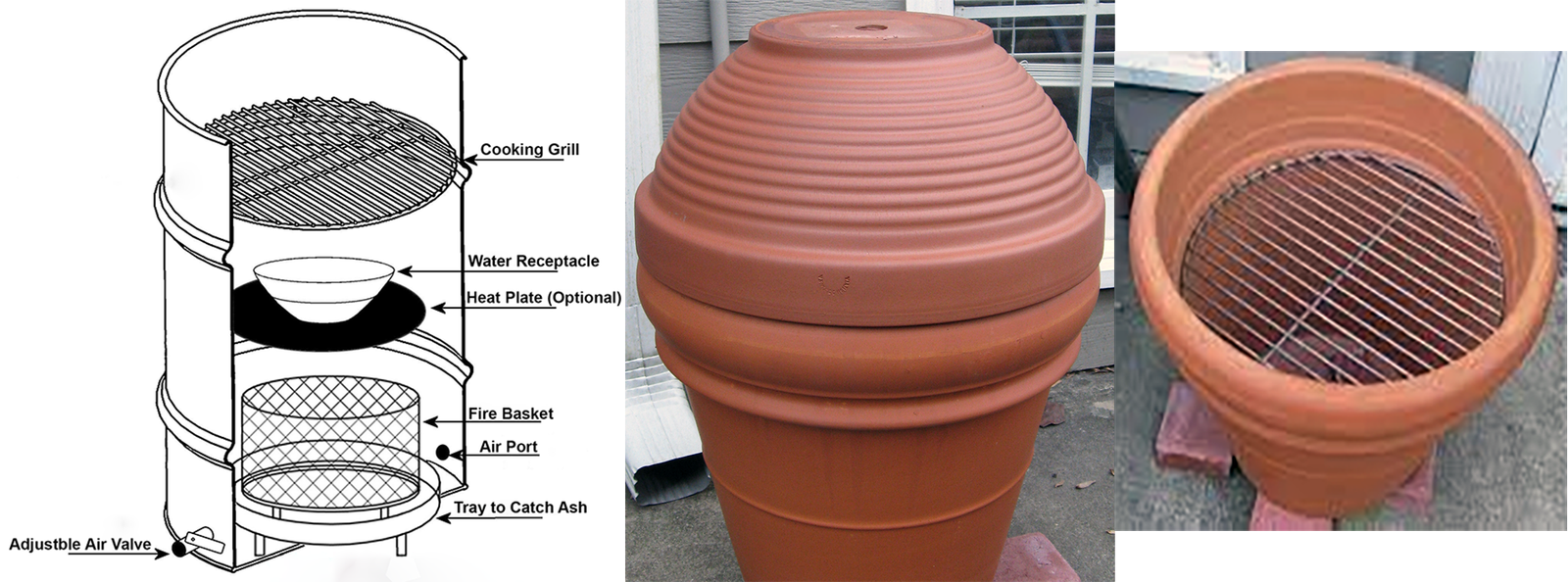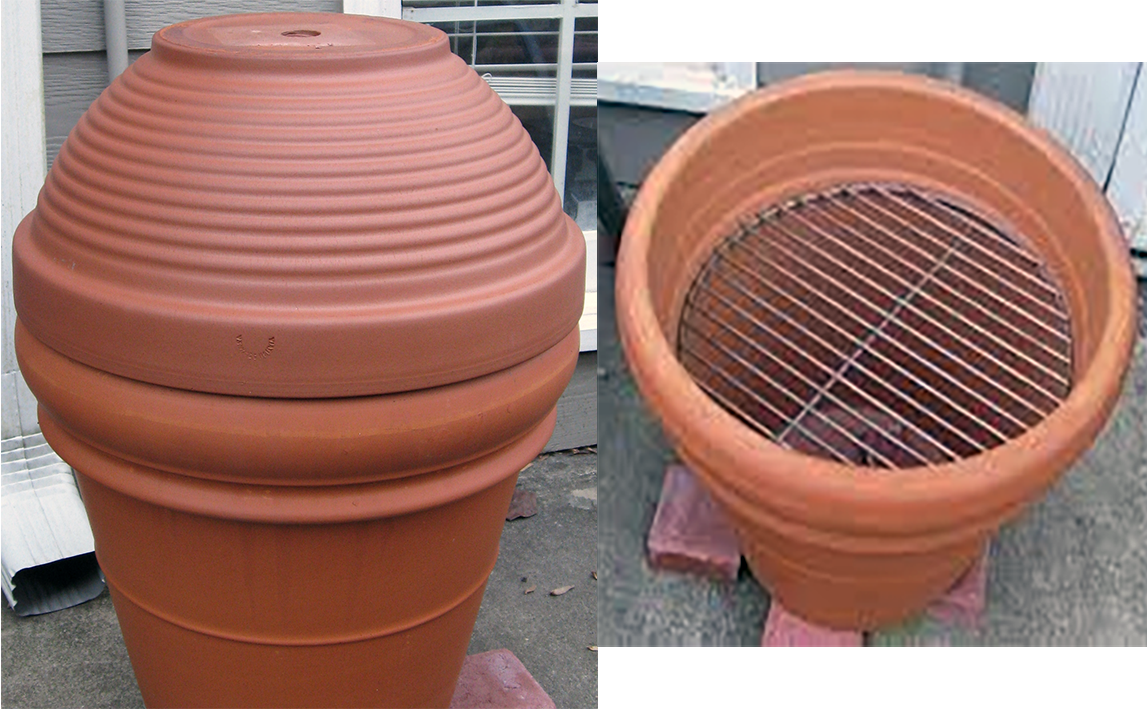FabulousFusionFood's Constructing a Home-made Hot Smoker Home Page
 Double clay pot hot smoker.
Double clay pot hot smoker.
Home Hot Smoker Recipes
Welcome to FabulousFusionFood's Cold Smoker Recipes Page — This article covers how to build a home-made hot smoker, along with a schematic and a simple realisation. The page also gives links to all the recipes on this site that are prepared with a hot smoker. Smoking is the process of flavouring, browning, cooking, or preserving food, particularly meat, fish and tea, by exposing it to smoke from burning or smouldering material, most often wood. In a hot smoker, the food is simultaneously cooked and smoked to flavour.
In Europe, alder is the traditional smoking wood, but oak is more often used now, and beech to a lesser extent.[clarification needed] In North America, hickory, mesquite, oak, pecan, alder, maple, and fruit tree woods, such as apple, cherry, and plum, are commonly used for smoking. Other biomass besides wood can also be employed, sometimes with the addition of flavouring ingredients. Chinese tea-smoking uses a mixture of uncooked rice, sugar, and tea, heated at the base of a wok.
 Schematic showing the structure of a hot smoker (left) and implementation with terracotta pots.
Schematic showing the structure of a hot smoker (left) and implementation with terracotta pots.
For a hot smoker, as a minimum you need a source of heat and smoke and a way of keeping the food to be smoked away from the fire (this could be a grate on which to set the meat) or rods from which you can suspend the meat.
It's also good to have a water source to create steam as this prevents the meat from drying out during cooking. A thermometer is advantageous to ensure the smoker remains hot. The device needs air holes to keep the fuel burning and it's good if this can be controlled to increase or reduce air flow to heat up or cool down the smoker.
A kettle or lidded barbecue can be made into an impromptu smoker by adding a bowl of water and leaves or something to increase the smoke then close the lid. An impromptu indoor smoker for an oven or stove top can be made with a combination of rice and tea in an aluminium tray.
 A terracotta hot smoker with using an all in one double clay pot design.
A terracotta hot smoker with using an all in one double clay pot design.The lower pot sits on three bricks. This means that the water drain hole acts as a route for ash to escape (which then falls between the bricks). Place a small piece of mesh over the drain hole and the base of the pot becomes your fire basket. The shoulder of the pot becomes the point on which the cooking grill sits. You can also remove the cooking grill and insert rods between the two pots so that food can be suspended. If you want a steam bowl just sit this on the cooking grill. It's also fairly easy to drill in to the top of the bottom pot so you can insert a probe-type thermometer. The drain hole of the bottom pot also becomes the air inlet vent to keep the fire going.
Note that smoke is both an antimicrobial and antioxidant, but it is insufficient for preserving food because it does not penetrate far into meat or fish; therefore, if the food is to be preserved, smoking is typically combined with salt-curing or drying. Smoking is especially useful for oily fish, as its antioxidant properties inhibit surface fat rancidification and delay oxygen from reaching the interior fat and degrading it. Some heavily salted, long-smoked fish can keep without refrigeration for weeks or months.
In cold smoking, no cooking is involved: The primary goal is to impart smoke flavour, not to cook the food through. Prior to cold smoking, curing is often needed: Many foods, like fish and meat, require curing (brining or dry salting) before cold smoking to ensure safety. Note that as it's the wood smoke that imparts flavour, different types of wood chips are used to achieve specific flavour profiles.
The alphabetical list of all the Hot Smoker recipes on this site follows, (limited to 100 recipes per page). There are 13 recipes in total:
Page 1 of 1
| Barbecued Megrim with Citrus Butter Origin: England | Smoked Beef Origin: British | Suffolk-cured Turkey Origin: British |
| Hot-smoked Sea Trout Origin: British | Smoked Chillies Origin: Mexico | To Cure Tongues I Origin: British |
| Magrets de Canard Fumés (Hot-smoked Duck Breasts) Origin: France | Smoked, Preserved, Mussels Origin: British | Whole Smoked Chicken Origin: African Fusion |
| Mousseline de fruit à pain (Breadfruit mousseline) Origin: Martinique | Smoked, Preserved, Oysters Origin: British | |
| Poulet Boucané (Buccaneer/Smoked Chicken) Origin: Martinique | Smoked, Preserved, Scallops Origin: British |
Page 1 of 1